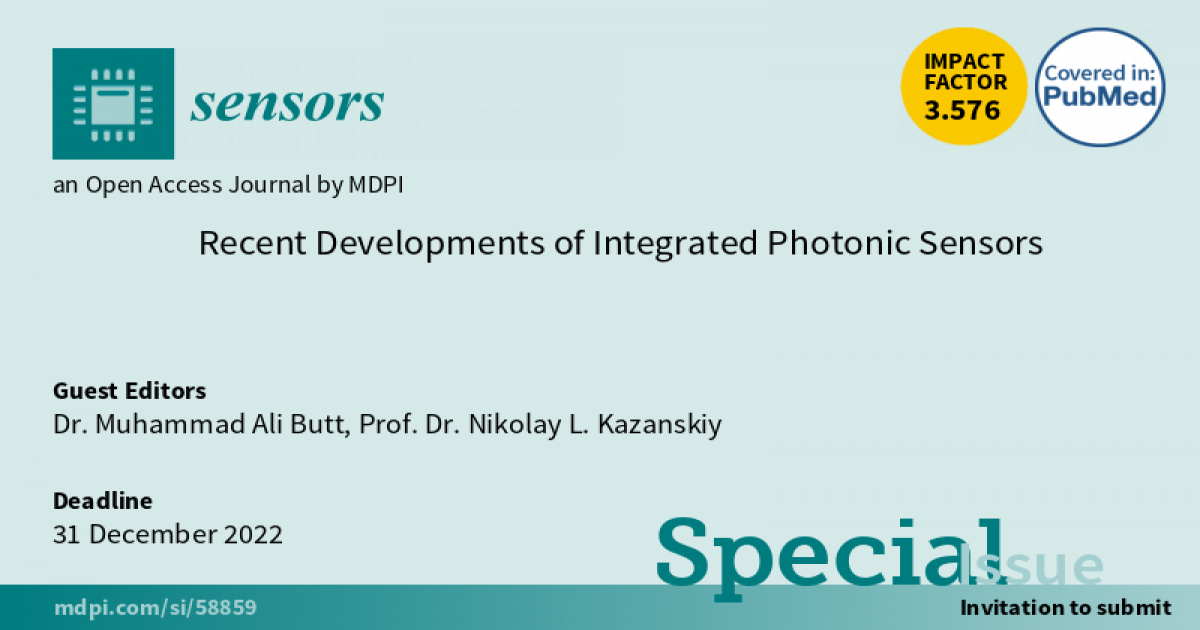Recent Developments of Integrated Photonic Sensors
A special issue of Sensors (ISSN 1424-8220). This special issue belongs to the section "Optical Sensors".
Deadline for manuscript submissions: closed (31 December 2022) | Viewed by 48054

Special Issue Editors
Interests: silicon photonics; plasmonic sensors; metamaterials; metasurfaces; non-diffractive beams; their applications
Special Issues, Collections and Topics in MDPI journals
Interests: computer optics; diffractive nanophotonics; computer vision
Special Issues, Collections and Topics in MDPI journals
Special Issue Information
Dear colleagues,
I am delighted to invite you to submit your valuable work for a Special Issue of the Journal Sensors on "Recent Developments of Integrated Photonic Sensors". In recent years, the development of highly integrated photonic sensors is taking place at a rapid pace. These devices can be employed in several eye-catching applications, such as monitoring/sensing of temperature, proximity, pressure, light, ultrasonic, chemicals, etc. This Special Issue will cover new developments and recent advances in the design, fabrication, and performance evaluation of integrated photonic sensors based on different platforms. Original research work, letters, and review papers based on theoretical, numerical, and experimental data are welcomed in this Special Issue.
Topics of interest include but are not limited to the following:
- Sensing applications based on metasurface/metamaterials;
- Plasmonic sensors;
- Photonic crystal sensors;
- Applications of integrated photonic sensors in, for instance, biomedicine, environmental monitoring, aeronautic, biochemical, etc.
We look forward to receiving your proposals.
Dr. M. Ali Butt
Prof. Dr. Nikolay L. Kazanskiy
Guest Editors
Manuscript Submission Information
Manuscripts should be submitted online at www.mdpi.com by registering and logging in to this website. Once you are registered, click here to go to the submission form. Manuscripts can be submitted until the deadline. All submissions that pass pre-check are peer-reviewed. Accepted papers will be published continuously in the journal (as soon as accepted) and will be listed together on the special issue website. Research articles, review articles as well as short communications are invited. For planned papers, a title and short abstract (about 250 words) can be sent to the Editorial Office for assessment.
Submitted manuscripts should not have been published previously, nor be under consideration for publication elsewhere (except conference proceedings papers). All manuscripts are thoroughly refereed through a single-blind peer-review process. A guide for authors and other relevant information for submission of manuscripts is available on the Instructions for Authors page. Sensors is an international peer-reviewed open access semimonthly journal published by MDPI.
Please visit the Instructions for Authors page before submitting a manuscript. The Article Processing Charge (APC) for publication in this open access journal is 2600 CHF (Swiss Francs). Submitted papers should be well formatted and use good English. Authors may use MDPI's English editing service prior to publication or during author revisions.
Keywords
- optical waveguide
- plasmonic sensor
- photonic sensor
- metamaterials
- integrated photonic sensor
Benefits of Publishing in a Special Issue
- Ease of navigation: Grouping papers by topic helps scholars navigate broad scope journals more efficiently.
- Greater discoverability: Special Issues support the reach and impact of scientific research. Articles in Special Issues are more discoverable and cited more frequently.
- Expansion of research network: Special Issues facilitate connections among authors, fostering scientific collaborations.
- External promotion: Articles in Special Issues are often promoted through the journal's social media, increasing their visibility.
- Reprint: MDPI Books provides the opportunity to republish successful Special Issues in book format, both online and in print.
Further information on MDPI's Special Issue policies can be found here.







